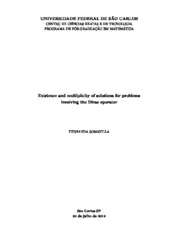| dc.contributor.author | Somavilla, Fernanda | |
| dc.date.accessioned | 2019-09-18T18:37:56Z | |
| dc.date.available | 2019-09-18T18:37:56Z | |
| dc.date.issued | 2019-07-30 | |
| dc.identifier.citation | SOMAVILLA, Fernanda. Existence and multiplicity of solutions for problems involving the Dirac operator. 2019. Tese (Doutorado em Matemática) – Universidade Federal de São Carlos, São Carlos, 2019. Disponível em: https://repositorio.ufscar.br/handle/ufscar/11856. | * |
| dc.identifier.uri | https://repositorio.ufscar.br/handle/ufscar/11856 | |
| dc.description.abstract | In this thesis, we study equations that involving the Dirac operator and which have the form
$-i \alpha \cdot \nabla u + a \beta u + M(x)u = F_{u}(x,u), em \mathbb{R}^{3},$
where $\alpha = (\alpha_1, \alpha_2, \alpha_3),$ with $\alpha_{j}$ and $\beta$ are complex matrices 4x4, j = 1, 2, 3 and a>0.Using variational methods and elements from critical point theory for strongly
indefinite problems we obtain existence and multiplicity results of solutions $u:R^{3} \rightarrow C^{4}$
under different sets of hypothesis about the potential M and the nonlinearity F: Firstly, we consider a problem with nonperiodic potential and concave-convex type nonlinearity, nonperiodic, which contain weight functions that can present signal change. Next, using the generalized Nehari manifold, we study problems in which nonlinearity satisfies weak monotonicity conditions and may relate to the potential function. Among such problems,we consider a periodic case and, due to the assumptions, in order to obtain the multiplicity results we use the Clarke's subdifferential and Krasnoselskii genus. Finally, we approach a problem with nonlinearity asymptotically linear at infinity and matrix potential. In this case, the potential is described by a sum of a non-positive suitable matrix potential and a diagonal matrix whose elements are function in some $L^{\sigma}, \sigma >1,$ which can change signal. | por |
| dc.description.sponsorship | Coordenação de Aperfeiçoamento de Pessoal de Nível Superior (CAPES) | por |
| dc.language.iso | eng | por |
| dc.publisher | Universidade Federal de São Carlos | por |
| dc.rights | Attribution-NonCommercial-NoDerivs 3.0 Brazil | * |
| dc.rights.uri | http://creativecommons.org/licenses/by-nc-nd/3.0/br/ | por |
| dc.subject | Dirac equation | por |
| dc.subject | Existence and multiplicity results | por |
| dc.subject | Linking arguments | por |
| dc.subject | Strongly indefinite functionals | por |
| dc.subject | Operador de Dirac | por |
| dc.subject | Funcionais fortemente indefinidos | por |
| dc.title | Existence and multiplicity of solutions for problems involving the Dirac operator | por |
| dc.title.alternative | Existência e multiplicidade de soluções para problemas envolvendo o operador de Dirac | por |
| dc.type | Tese | por |
| dc.contributor.advisor1 | Paiva, Francisco Odair Vieira de | |
| dc.contributor.advisor1Lattes | http://lattes.cnpq.br/2889322093175193 | por |
| dc.contributor.advisor-co1 | Miyagaki, Olimpio Hiroshi | |
| dc.contributor.advisor-co1Lattes | http://lattes.cnpq.br/2646698407526867 | por |
| dc.description.resumo | Nesta tese, estudamos equações que envolvem o operador de Dirac na forma
$-i \alpha \cdot \nabla u + a \beta u + M(x)u = F_{u}(x,u), em \mathbb{R}^{3},$
onde $\alpha = (\alpha_1, \alpha_2, \alpha_3),$ sendo $\alpha_{j}$ e $\beta$ matrizes complexas 4x4, j = 1, 2, 3 e a>0. Utilizando métodos variacionais e elementos da teoria de pontos críticos para problemas fortemente indefinidos obtemos resultados de existência e multiplicidade de soluções $u:R^{3} \rightarrow C^{4}$ sob diferentes conjuntos de hipóteses sobre o potencial M e a não-linearidade F. Inicialmente, consideramos um problema com potencial não periódico e uma não-linearidade do tipo côncavo-convexo, não periódica, contendo funções peso que podem apresentar mudança de sinal. Em seguida, utilizando a variedade de Nehari generalizada, estudamos problemas em que a não-linearidade satisfaz condições de monotonicidade fraca e pode se relacionar com a função potencial. Dentre tais problemas, consideramos um caso periódico e, devido as hipóteses, para obter resultados de multiplicidade utilizamos o subdiferencial de Clarke e o gênero de Krasnoselskii. Finalmente, abordamos um problema com não-linearidade assintoticamente linear no infinito e potencial matricial. Neste caso, o potencial é descrito como uma soma de um potencial matricial não positivo adequado e uma matriz diagonal cujos elementos são funções em algum espaço $L^{\sigma}, \sigma >1,$ as quais podem mudar de sinal. | por |
| dc.publisher.initials | UFSCar | por |
| dc.publisher.program | Programa de Pós-Graduação em Matemática - PPGM | por |
| dc.subject.cnpq | CIENCIAS EXATAS E DA TERRA::MATEMATICA::ANALISE::EQUACOES DIFERENCIAIS PARCIAIS | por |
| dc.subject.cnpq | CIENCIAS EXATAS E DA TERRA::MATEMATICA | por |
| dc.description.sponsorshipId | CAPES: Código de Financiamento 001 | por |
| dc.publisher.address | Câmpus São Carlos | por |
| dc.contributor.authorlattes | http://lattes.cnpq.br/0280451137694299 | por |


